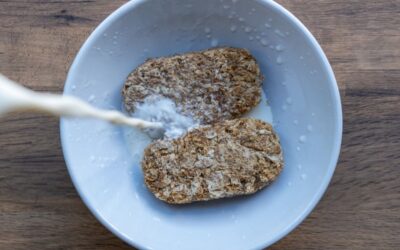Feeding an 11-month-old: think less about calm mealtimes and more about attempting to remove bolognese from the nooks and crannies of the highchair.
From refusing the spoon like a seasoned warrior to firing foods with unmatched enthusiasm, weaning at this age takes no prisoners.
Your kitchen may never be the same, but I hope you’ll enjoy it despite the chaos and have many messy memories.

The mess is far from being over at 11 months!
Nutrient requirements for 11-month-olds
According to First Steps Nutrition, to complement the energy that a baby will get from breastmilk or about 400ml of infant formula, they estimate that an 11-month-old will need about 450kcals from food.
However, this figure is an average and babies will have variable appetites and energy needs and should be encouraged to eat to appetite.
They estimate that an 11-month-old will need about the following nutrients from their food each day:
- 9.7g protein
- 325mg calcium
- 5.8mg iron
- 2.6mg zinc
- As well as fat, carbohydrates and a range of other vitamins and minerals that their foods will provide.
Why are Mealtime Routines important for babies?
Mealtime routines are crucial for babies as they provide predictability, security, and a positive association with food. Consistent routines also help regulate hunger cues, encourage healthy eating habits, and foster a nurturing environment.
Mealtime routines contribute to your baby’s overall physical and emotional well-being. And yours, too, as most busy parents find life more manageable with even the loosest routine.
Sample overview of Mealtime and milk routine at 11 months for breastfed or formula-fed baby

Mealtime Routine at 11 months in more detail
Morning (7:00 AM – 8:00 AM):
Start the day with a simple but nutritious breakfast. Breakfast doesn’t need to be a ‘recipe’ or anything fancy. Sharing a bowl of your favourite porridge, making a quick bowl of Ready Brek, and offering some fruit as finger food is perfect!
LEARN MORE: 7 days of simple baby breakfast ideas that you can easily share
Mid-Morning Snack (10:00 AM):
You can start introducing a mid-morning snack at this stage if you haven’t done so already. Snacks help to keep those tiny tummies content. It’s best to think of snacks as ‘mini meals’ rather than specific types of foods like rice cakes or baby snacks.
You’ll find some appropriate snack ideas further down this blog.
Lunch (12:30 PM):
Lunch is an opportunity for a well-rounded meal containing a mixture of mashed or finely chopped foods your baby eats from a spoon (you can help and encourage them to feed themselves) and finger foods.
LEARN MORE: The Tricky Third Meal-Quick and Easy Baby Lunch Ideas
Afternoon Snack (3:00 PM):
You can start introducing another snack or ‘mini meal’ now.
Dinner (6:00 PM):
As the day winds down, focus on a family dinner, where possible. Aim to adapt your family food to make it suitable for your baby. At 11 months, it’s important to continue offering foods low in salt and sugar. And, of course, you must ensure that the texture you’re offering is safe for your baby.
If you can, eat together as a family. If this isn’t possible, no problem. You can feed your baby and eat later.

This image shows what NOT to do when feeding your baby! The food is kept away from the baby’s reach and instead of sitting with their baby this couple are right in their baby’s face.
Balanced meals for 11-month-olds
Balancing meals during the weaning phase is crucial for providing essential nutrients to support your growing baby.
Here’s the Rule of Thumb that I teach parents when planning balanced weaning meals
- Iron-rich food: Offer finely chopped meats, lentils, beans, eggs and fortified cereals to provide a crucial source of iron. Iron supports cognitive and physical development during weaning.
- Energy-rich food: Incorporate carbohydrate-rich foods like potatoes, rice or pasta, high-fat foods like avocado, or dairy products like cheese and yoghurt for a supply of healthy fats and calories. Energy helps your baby grow and thrive.
- Fruits/Vegetables: Include a variety of fruits and vegetables for vitamins and minerals, help them accept a wide range of foods, and lay the foundation for lifelong healthy eating habits during the weaning phase.
5 Age-appropriate snacks for 11-month-olds
- Banana + plain yoghurt with smooth peanut butter
- Cucumber sticks + Hummus
- Tomato slices and hard-boiled egg
- Avocado + toast with milled chia seeds
- Baked Beans + toasted bagel
Formula feeding routine for 11-month-olds
At 11 months, formula-fed babies typically consume around 400mls (13-14oz) of formula daily, spread across two or three bottles or cups, depending on your family’s schedule. Individual needs may vary, so monitoring your baby’s cues for hunger and fullness is essential.
Your baby mustn’t fill up on milk before meals as they may be less interested in trying new foods and eating increasing amounts so that milk may fit better before naps or after meals.
A typical formula feeding routine at this age might look like this:
Option 1:
Breakfast, 4oz bottle, snack, lunch, 4oz bottle, snack, dinner, 5oz bottle before bed.
Option 2:
Breakfast, 7oz bottle, snack, lunch, snack, dinner, 7oz bottle
LEARN MORE: How to switch from formula to cow’s milk?

Breast milk continues to provides nutrition, comfort and immune protection at 11 months
Breastfeeding schedule for 11-month-old
Congratulations, you’ve successfully breastfed for 11 months! Your baby has received a substantial immune system boost, essential nutrients, and the unique comfort that breastfeeding provides.
Continue to feed on demand or responsively, and as food intake increases, breastmilk intake will decline. There’s no need to know how much milk your breastfed baby drinks – follow your baby’s cues. And, of course, breastfeeding may also be about comfort, nurturing, and not food!
Reflect on your breastfeeding goals as you approach your baby’s first birthday. If you plan to continue breastfeeding after 12 months, be prepared to adjust your routine to accommodate your baby’s changing needs. At this stage, breast milk remains an essential part of your baby’s diet, offering nutrition, comfort, and emotional connection.

You’re in charge of FEEDING, your baby is in charge of EATING
Parenting tips for feeding an 11-month-old
Offer chances to drink water at meals:
- Offer sips of cooled, boiled water from a sippy cup (opt for a little open cup, straw cup or free-flowing beaker) with meals. While breast milk and formula are the primary sources of fluid, introducing water gradually helps your baby become accustomed to it and teaches them how to drink from a cup.
- There’s only ONE more month left where you need to boil the before offering it to your baby. Once they hit their first birthday, you won’t have to do this anymore.
Don’t forget to feed your baby responsively:
- Pay close attention to your baby’s hunger and fullness cues. Whether breastfed or formula-fed, responsive feeding ensures that your baby consumes the appropriate amount for their needs. Don’t compare what your baby eats to your friend’s baby or an older sibling. Every baby is different.
READ THIS: Portion sizes during weaning
Keep offering new textures and flavours:
- Continue introducing a variety of textures and flavours, allowing your baby to explore different tastes. By 11 months, your baby should be able to manage a range of minced and chopped foods. Adapt your family’s meals rather than making separate ‘baby food’ where possible.
Create a peaceful environment at mealtimes:
- Create a positive and relaxed mealtime environment. Limit distractions, engage with your baby during meals, eat together where possible and make mealtimes an enjoyable and low-pressure environment.
Encourage your baby to Self-Feed:
- As your baby’s motor skills develop, encourage self-feeding by offering age-appropriate finger foods. This not only supports their independence but also enhances their fine motor skills.
By 11 months, babies can start to have a bigger range of finger foods with their meals. Examples Include:
- Raw fruit and vegetable pieces (with any pips and stones removed) – ripe pear, banana, orange segments, quartered cherries or grapes and cucumber
- Dried fruit – such as chopped soft dried prunes or ready-to-eat apricots cut into pea-sized pieces
- Starchy foods such as breadsticks, baby plain rice cakes, pitta bread strips, toast, potato, and pasta
- Other foods – soft cooked meat or fish (without bones) – hard-boiled egg – cooked soft peas and chopped beans – pulses such as cooked lentils – cheese –smooth nut or seed butter (such as tahini) spread thinly on strips of bread or pitta bread.

Feeding an 11 month old is not all plain sailing!
Common challenges in feeding 11-month-olds
Feeding an 11-month-old can be rewarding and challenging as your little one navigates the exciting world of eating and family meals. While it’s an exciting time of exploration and increasing independence, it’s not uncommon for parents to encounter some challenges with feeding.
Let’s take a look at what might be coming up:
1. Fussy Eating Emerges:
– As your baby’s preferences develop, they might exhibit signs of fussy eating, expressing clear likes and dislikes.
– Introduce various foods without pressure to encourage a diverse palate and remain patient as their tastes develop and change. Just because they don’t like food now doesn’t mean they never will.
-never try to persuade or trick your baby into eating.
-Parent Provides (you decide what foods to offer), Child Decides (it’s up to your baby how much and whether to eat at each meal)
2. Increased Independence:
– With newfound motor skills, your baby may resist being spoon-fed, preferring to feed themselves.
– Offer age-appropriate finger foods to encourage self-feeding and support their emerging independence.
3. Teething Troubles:
– Teething discomfort can affect appetite and willingness to eat.
– Provide soothing teething tools and chilled, soft foods to ease gum discomfort.
4. Distractions During Meals and milk feeds:
– As curiosity grows, your baby may become easily distracted during meals and breastfeeding.
– Create a calm and focused mealtime environment, minimising distractions to promote healthy eating habits. Be realistic about the length of meals. You may find you need to bring your baby to a quiet, dark room to breastfeed.
5. Difficulty accepting more textured foods
– Moving from purees to more textured foods can be challenging.
– Gradually introduce finely chopped or mashed foods to help your baby adjust to different textures.
-Let your baby get messy with food and encourage self-feeding. Many babies prefer to feed themselves more textured food rather than have it delivered into their mouth from a spoon!
-If concerned, speak to your GP and request a feeding specialist referral.
6. Drinking too much formula
While breastfed babies will reduce their milk intake as the intake of solids goes up, many formula-fed babies continue to drink the same amount of formula. Aim to offer about 400mls of formula per day.
7. Inconsistent Appetite:
– Appetite fluctuations are expected at this stage.
– Pay attention to your baby’s hunger cues and adjust portion sizes accordingly, avoiding pressure to finish every meal.
You need lots of patience and flexibility to deal with these challenges. Knowing what’s coming down the track is the first step in saving your sanity!
Addressing these obstacles with a positive and responsive approach creates an environment in your home that promotes a good relationship with food and helps to reduce stress at mealtimes.
Feeding your Toddler Online Course
Enjoy each stage in your baby’s development. It’ll never happen again! Take lots of photos, and remember your routine doesn’t need to be perfect to be good enough.
Easy ways to serve Weetabix for babies-and why to do it!
There’s no shortage of fancy baby breakfast ideas around. But why not keep it simple? This blog shows you how to serve Weetabix for babies and why to feel good while you do it!
7 secrets to understanding why your two-year-old isn’t eating well
Two-year-old not eating well? You’re probably not alone. Let’s look at what’s normal for toddlers and eating. I promise you it will make you feel better.
How to introduce cows milk to baby-your ultimate guide
Everyone has their own opinion about when can babies drink cows milk. In this blog, you'll get answers to all your questions about introducing your baby to cow's milk. "No cow's milk before one", advises your mother. "Introduce cow's milk ASAP. They'll get an...









0 Comments